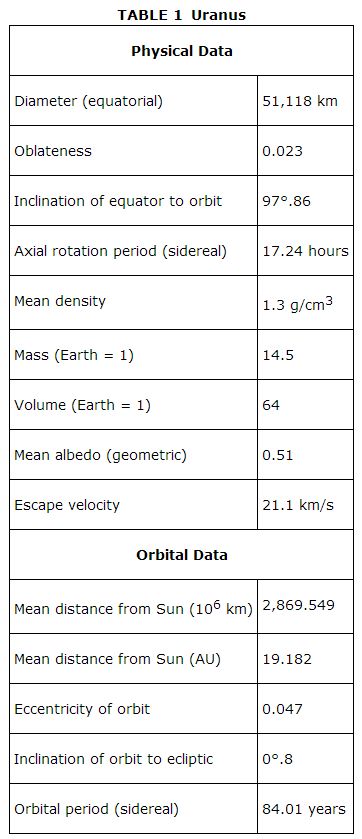Although another gas‐giant planet whose deep atmosphere is composed primarily of hydrogen (74 percent) and helium (26 percent), Uranus appears as a nearly featureless greenish ball because of methane in the outer atmosphere and an apparent lack of strong convection. At a temperature of 65 K, ammonia and water, which are responsible for the clouds of Jupiter and Saturn, have frozen out and “snowed” into the planet's interior. The gaseous methane that remains behind in the upper atmosphere absorbs red light; hence sunlight, reflected back into space, gives the planet its greenish color.
In size (four times that of Earth) and mass (14 times that of Earth), Uranus is almost a twin of the planet Neptune; though slightly less massive than Neptune, it is slightly larger in radius because of its weaker gravity. Compared to Jupiter, Uranus has a relatively larger iron/rocky core (see Figure ). Its major distinguishing feature is a rotational axis nearly in the plane of the solar system, a factor that certainly must have been a product of its formation (it was affected either by a major collision or resulted from the merger of two nearly equal bodies). In contrast to the three other gas‐giant planets, Uranus is in balance between the energy it emits and the energy it absorbs from sunlight. Without internal heat moving slowly outwards by convection, no equatorial cloud bands can be produced, even though the planet's rapid rotation is accompanied by a strong Coriolis effect. (See Table 1 for Uranus's physical and orbital data.)

Figure 1
The interior of Uranus
.
|
|
|
|
|
|
|
|
|
|
|
|
|
|
|
|
|
|
|
|
|
|
|
|
|
|
|
|
|
|
|
|
|
|
|
|
|
|
|
|
|
|
|
|
|
|
|